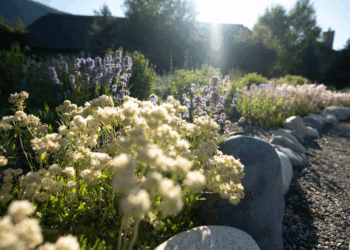By Paul Swenson EBS COLUMNIST

While I spent time around town in late April, I kept hearing people lamenting the long winter. As a first-year retired teacher I must say that it was the best winter I could have asked for. Skiing during the week at the resort, and skiing adventures with my wife either in the backcountry or resort on the weekends, made for a quick winter for me. We still are crust cruising up in Yellowstone National Park at least until mid-May.
But now the snow has disappeared in the low country and one of my other favorite activities has started: finding the first and most beautiful of each of the regional flower species we have. I would like to share with you the most obvious choices since I have a limited amount of space here in the paper.
The first flower that blooms in our region is the Sagebrush Buttercup. They show up within a week of the snow disappearing out in the sagebrush covered flats along the Gallatin River, or down in the valley. We found some two weeks ago during an afternoon walk close to Porcupine.

After finding the buttercups, keep an eye out for the Hookedspur Violet, also known as the early blue violet. Both these plant species are small and inconspicuous, but once you spot them you know spring is officially here.
The next two species that emerge are my favorite early bloomers: the Dogtooth Violet, also known as the Glacier Lily, and the Pasque Flower. You can find Glacier Lilies within inches of a receding snowbank. I found a little patch of these blooming by the Green Bridge today, May 10. As the snow disappears slowly at higher elevations throughout the summer, you can find these flowers through mid-July in the alpine.
Pasque Flowers come and go in a hurry, so once you find them, usually in late May, early June, tell your friends and flower lovers because they’ll be gone in a week. My sister and I have an informal competition to find the first, most, and hairiest one. The name Pasque is attributed to the French spelling of the Hebrew word for Passover, “Pasakh.” In other regions of the world, Pasque flowers usually bloom around Easter.
A quote from “A Sand County Almanac” by Aldo Leopold references this flower in a very apropos manner for our region:
Like winds and sunsets, wild things were taken for granted until progress began to do away with them. Now we face the question whether a still higher ‘standard of living’ is worth its cost in things natural, wild, and free. For us of the minority, the opportunity to see geese is more important than television, and the chance to find a pasque-flower is a right as inalienable as free speech.

The last three flowers I would like you to look for usually start blooming at the beginning of June through the middle of July: Larkspur, Shooting Stars and Fairy Slippers.
Larkspur is an intensely colored purple flower whose name originates in Shakespearean England. The horn shaped nectar producing petal resembles the spur claw on a lark’s foot. It is referenced as “Lark’s Heel” by Shakespeare in the late 1500’s.
Several different indigenous groups extracted the purple pigment from the flowers to use as dye in ceremonial artwork and clothing. The pigments were also used in European countries as ink.
Shooting Stars usually bloom in conjunction with Glacier Lilies, or slightly behind. They were my favorite flower as a kid, and still rank in my top five. Their pinkish purple color is very distinct and will be noticed immediately on a hillside.

Last is the Fairy Slipper. It is a wild orchid, one of the few in Montana, and the only one in the mountains surrounding Big Sky. They are difficult to find, but once you do, keep looking around in that area and you are bound to find more. They are a delicate plant and one should take care not to disturb the plant or soil when observing.
I hope that you can get out in the next three weeks and find these flowers. Porcupine Creek trail, lower Beehive Basin trail, Taylor Fork, and Teepee Creek trails are all great places to find these beauties. Please do not pick these flowers. They will not last more than a day or two in a vase anyway, and it’s best to let others enjoy them also. Take photos! Get down low, close to the ground with your cell phone and shoot them with the sun behind them. Better yet, shade them with your hand so the light is not intense or direct. Try to get a dark background for intense colors.
Paul Swenson has been living in and around the Big Sky area since 1966. He is a retired science teacher, fishing guide, Yellowstone guide and naturalist. Also an artist and photographer, Swenson focuses on the intricacies found in nature.














